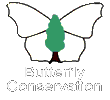
| Butterfly Conservation |
|
| saving butterflies, moths and their habitats |
 |
|
|||
|
| ||||
| Sussex Branch | ||||
|
| ||||
|
|
Lullington Heath NNR, East Sussex ***
Grid ref: TQ545 016 Nearest town: Equidistant between Eastbourne and Seaford.
Lullington Heath National Nature Reserve occupies a high position on the South Downs between the villages of Litlington and Jevington. The NNR was established in 1954 to conserve one of the largest areas of rare chalk heath in Britain. Chalk heath occurs where acid soils are found on chalk or lime bedrock. At Lullington Heath, a slightly acidic fine soil covers the chalk to a depth of about 20 cm in some areas. This allows acid-loving species such as Heather, Bell-heather and Tormentil to grow amongst more chalk-loving downland plants such as Thyme, Salad Burnet and Dropwort. Chalk heath covers just under a third of the the Reserve. Elsewhere, bushes, chalk grassland and valley grassland form a patchwork across the site. Over 250 types of plant and 34 species of butterfly have been found here.
Access details Access on foot only, a long walk either from Litlington (limited car parking) or from Jevington (small car park at church)
Key species Silver-spotted Skipper, Adonis Blue, Grayling, Chalkhill Blue, reliable site to see good numbers of Dark Green Fritillary and Small Copper, Common Blue, Brown Argus, Grizzled Skipper and Dingy Skipper. The Hornet Robber-fly Asilus crabroniformis has been recorded on site Other common species Good place to see plenty of common butterflies - browns, Red Admiral etc Site description Management is targeted at maintaining this rare chalk heathland habitat. There are large areas of scrub, important for birds, especially migrants.
Authors Graham Parris and Adrian Thomas
|
||||||||||||||||||||||||||||||||||||||||||||||||||||
|
|
|
|
| Copyright Butterfly Conservation © 2006 Sussex Branch |
|
|
| Privacy and Copyright Statement |
|
|
| Butterfly Conservation is a registered charity and non-profit-making company, limited by guarantee. Registered in England No.2206468. Registered Charity No.254937. |
|
|
|
|